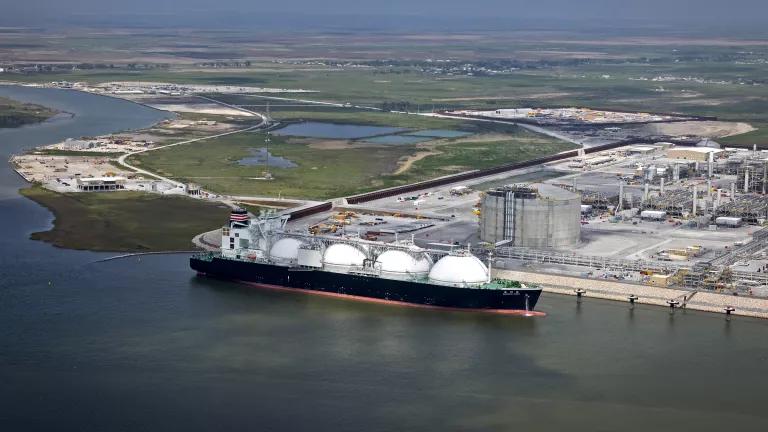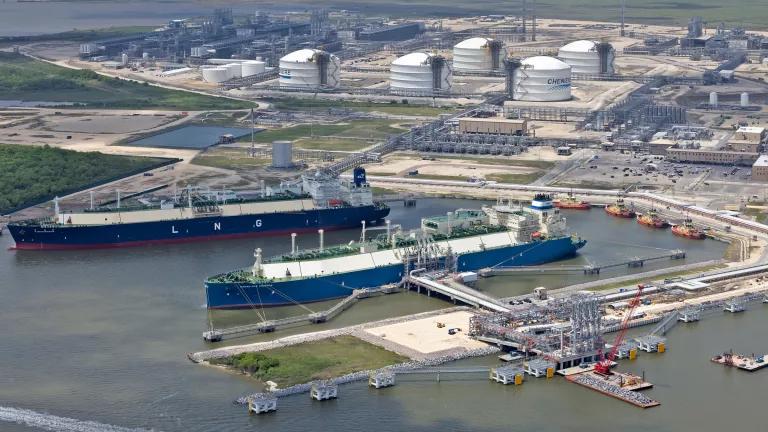Liquefied Natural Gas Exports Are a Climate Threat
Increasing overseas exports of liquefied natural gas could make it impossible to limit global warming to 1.5 degrees Celsius.

A liquefied natural gas tanker ship docked at Venture Global’s Calcasieu Pass export facility in Louisiana
Julie Dermansky for NRDC
Increasing overseas exports of liquefied natural gas (LNG), far from being the climate-friendly replacement for dirtier fossil fuels touted by the gas industry, will make it more difficult for both the U.S. and importing countries to reduce greenhouse gas (GHG) emissions. In fact, “locking in” this fossil fuel for the coming decades could make it impossible to limit global warming to 1.5 degrees Celsius.
A new analysis by NRDC, which reviewed research by government agencies, university scientists, and energy consultants, shows that LNG exports have, at best, little climate benefit compared to other options. In fact, when looking at the full life cycle emissions of different energy sources, U.S. LNG was typically a higher-emitting option than other sources of gas, such as more regional sources of LNG or pipeline gas, and much worse than new wind or solar power. While the studies found a modestly lower GHG footprint for U.S. LNG as compared to coal, this “benefit” disappears if higher amounts of methane (a potent GHG) leak or are purposely “flared” or vented into the atmosphere during drilling, transport, and processing of the gas.

Life-cycle greenhouse gas emissions from North American–produced LNG exported to Europe and Asia compared with life-cycle emissions from LNG exports from Africa and Australia (regional LNG), regionally produced coal, Russian pipeline gas, solar, and wind.
New research shows that U.S. gas and oil producers are flaring more methane than ever—and at much higher rates than assumed by the federal government. Last year, more gas was wasted in just two U.S. oil fields than consumed annually by homes in 23 states combined.
These higher rates of flaring and venting (as well as higher rates of methane leaks) matter immensely for the climate calculus for LNG exports. By some estimates, the near-term global warming effect of this leaked methane has a climate impact comparable to that from actually burning the gas. Climate conscious countries are catching on; France blocked a deal to import U.S. LNG over concerns that its excessive methane emissions made the gas too climate intensive.
We also found:
- Overseas export of gas adds to its climate impact. Liquefaction, tanker transport, and regasification increase total life-cycle emissions by as much as 21 percent.
- Compared to clean, renewable energy sources, LNG falls far short. Life-cycle GHG emissions for solar power are less than 7 percent of LNG emissions; emissions for wind power are even lower, less than 2 percent of LNG emissions.
- If the U.S. LNG industry expands as projected, by 2030, the domestic emissions from the U.S. LNG industry alone would be equivalent to annual emissions of 28 million to 45 million gasoline cars. And none of these emissions come from burning the gas, which will instead be used to provide energy in Europe and Asia.
Federal agencies have a key role to play, but current review and approval processes for LNG projects are woefully weak. At the same time, rules requiring the gas industry to monitor and fix methane leaks have been rolled back by the Trump Administration. These industry friendly policies are facilitating both the growth and excessive emissions of this climate threatening industry.
Exporting LNG will not help the world meet its climate goals. The U.S. should instead prioritize clean energy investments at home and abroad. Based on our analysis, we make the following recommendations:
- LNG export is too high risk: NRDC opposes LNG export due to the substantial climate risks it poses, including its large GHG footprint, the long life span of LNG infrastructure that locks in fossil fuels instead of clean energy, and methane leaks that can eliminate any climate benefit even if LNG is used to replace coal. Policymakers and regulators should not approve or support any LNG project in the absence of a quantifiably demonstrated climate benefit relative to all alternatives, based on fully disclosed life-cycle emissions, and should require clear destination and usage restrictions. No such demonstration has been made nor restrictions applied with respect to any of the United States’ currently approved or operational LNG export facilities, and existing regulatory approval processes fail to meaningfully consider LNG’s full environmental impacts.
- No subsidies for LNG-related infrastructure: The U.S. government should not subsidize LNG-related infrastructure with public subsidies or other incentives through, for example, the Export Import Bank of the United States, World Bank, or U.S. Development Finance Corporation. The United States should instead be providing other countries with clean, efficient, and cheaper sustainable alternatives to fossil fuels; offering U.S. innovations in technologies, services, and products; and leading by example by transitioning to a clean energy economy at home.
- Developers must account for and disclose full LNG life-cycle emissions: Proposals for LNG infrastructure must include disclosures on the full life-cycle GHG emissions of LNG, including all indirect and cumulative emissions, as these often account for the majority of emissions from a project and cannot be dismissed (these requirements include Scope 3 indirect GHG emissions coverage).
- Methane leakage must be controlled: Much of LNG’s sizable climate impact comes from methane leaks that occur throughout the production, processing, and transport of the gas. It is imperative that the United States (including state governments, as appropriate) develop and implement strategies to effectively curtail leakage.
- Financial institutions should evaluate projects on full life-cycle impacts: Any LNG project considered by a financial institution should be evaluated on the basis of the full direct, indirect, and cumulative GHG emissions impacts of the project. Financiers must accurately calculate the financial risks of high-carbon projects, as recommended by the Task Force on Climate-Related Financial Disclosures.
- U.S. regulators must fully consider the range of impacts from LNG exports: U.S. regulatory bodies charged with reviewing applications for LNG export and its affiliated facilities, especially the Federal Energy Regulatory Commission and the Department of Energy, should ensure that a publicly transparent, thorough, robust, and comprehensive assessment of all relevant factors, including life-cycle GHG emissions, local and regional air pollutants, impacts to frontline communities, project alternatives, and all other upstream, downstream, and cumulative environmental impacts, is conducted and subject to public input prior to issuing a final decision.




